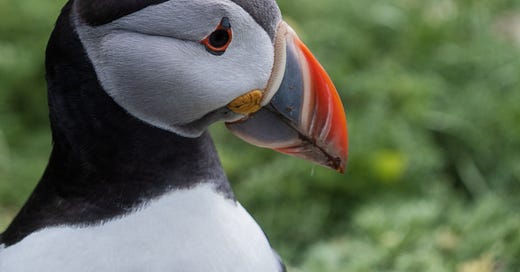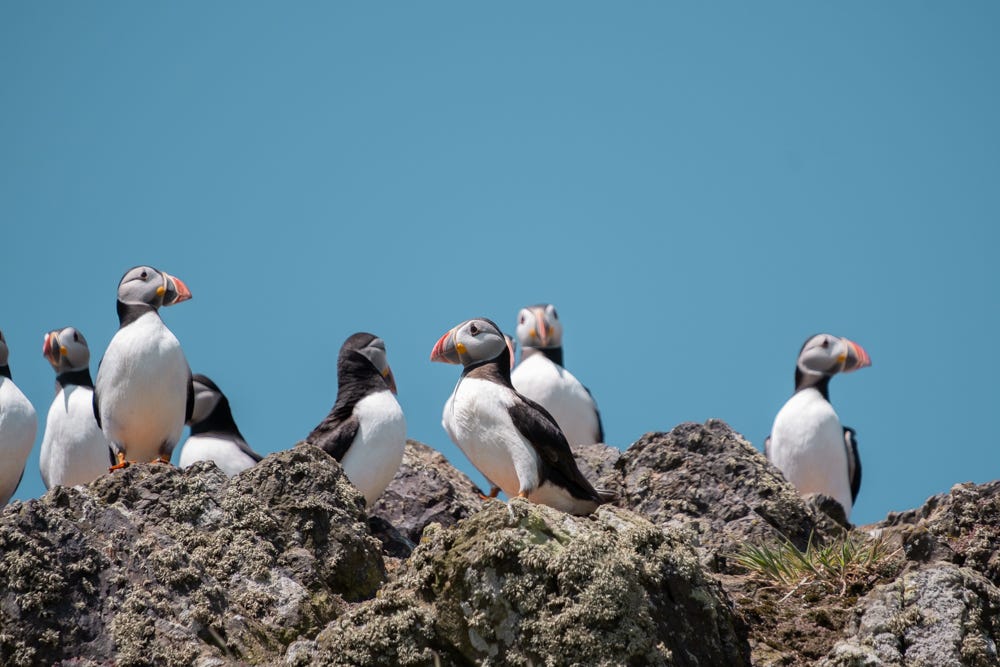It’s mid-July and I’m queuing in the village shop after popping out for a loaf of bread and block of mild cheddar.
The man in front is buying two cans of local ale and a couple of sharing bags of crisps. He’s barefooted and topless, his wetsuit hanging from his waist. Like a half-peeled banana.
Tomorrow, driving into the village, I’ll pause as another barefooted man stands in the road, pondering whether to finish crossing or eat his fish and chips there and then. He’s zipped up in a Dryrobe. Like an unpeeled banana.
The weather may no longer be a reliable guide to the seasons, but these sights are a sure sign that we’re entering summer holiday time. A time when our village on the north coast of Cornwall bulges at the seams and we have to patiently and politely navigate around and between the visitors to go about our daily lives.
And that is one thing I have in common with a puffin1. Specifically, a Skomer Island puffin.
A month earlier, we are the visitors getting in the way of the locals going about their business.
Less than a mile out to sea, Skomer is just a short boat trip from the small Pembrokeshire bay of Martin’s Haven, where baby swallows squeak from a nest above the cubicle in the gents. If these birds are in my personal space, on Skomer the roles are reversed.
Technically, Skomer’s puffins are visitors too, but while we spend four hours on the island, they are there for three months every year, from April to July, and come in huge numbers – around 42,500 at the last count.
They escort the boat with a flap-to-speed ratio of ‘wow, that looks like hard work’. They gather in welcoming committees above the steps up from the dock. And at prime spots on the island, like The Wick, they are everywhere.
We head straight there, along paths bordered by carpets of red campion, only briefly delayed by a man crouching in front of us to photograph a bird that isn’t a puffin. “A wheatear,” he says. “Ooh, lovely,” we say. Anyway, move along, because PUFFINS.
There are strict instructions to stay behind the ropes and to give way to the puffins. While in so many of our encounters wildlife makes way for us, on Skomer it really feels like you are on their patch.
But however much you try, you can’t escape the feeling you’re in the puffins’ way as they patiently and politely navigate around and between the visitors to go about their daily lives.
They pace up and down, round and round, some with colourful bills packed with sand eels, waiting for an opportunity to cross the path with the kind of silly run–walk that I might employ when crossing a busy road.
As Clare rests on a bench, she feels a presence behind her: a puffin doing everything but giving a little cough and an embarrassed “excuse me!” As she stands and steps to one side, the bird scuttles under the bench, across the path and out over the cliff.
“I’ve never seen them go that way,” says a warden with whom I then slip into chough nerdery as half a dozen Welsh versions of Cornwall’s national bird probe the short grass for bugs and grubs.
Because while puffins steal the show on Skomer, they are far from the only bird there. In fact, Manx shearwaters outnumber them around 20 to one – but the dried-out husks of ex-Manx shearwaters are the only sight you’ll catch of them unless you are on the island after dark. Then there are all the birds nesting on the cliffs of The Wick: swirling peregrine falcons, growling razorbills and guillemots in their hundreds, lining the ledges shoulder to shoulder.
And then there are the gulls. Great black-backed gulls command the higher ground inland, while herring and lesser black-backed gulls loiter, waiting for an opportunity to pounce on scraps or even mug a puffin for its catch. We watch a herring and lesser black-backed gull argue over territory for such crimes, tearing at the grass and weeds in a show of aggression like two footballers squaring up without actually coming to blows.
The gulls may be key to why Skomer’s puffins are so tolerant of us visitors. It’s thought that the human presence deters gulls from landing, meaning a puffin can more safely deliver sand eels to their burrow. Just as the visitors help to keep our village shop running, meaning I can pop out for a loaf of bread and block of mild cheddar whenever I need to.
Basking sharks seen on this walk: 0
Total basking sharks seen to date: 0
This would have been the only thing I have in common with a puffin, but the other day my stomach made the exact rurrr-rurrr-rurrr-RURRR revving sound that a puffin makes. I blame the sand eels.






I really like your philosophy on tourists at the end. Having grown up in a national trust village near Cambridge I’ve always found it a mark of pride that people would travel for miles to come and visit. Yes the crowds in the summer would be frustrating and snowdrop season used to be a pain for parking (now they’ve built a proper carpark it’s much better!) but how lucky I am to have lived in a place where I can see the beauty anytime for free!
That sounds an amazing trip, and what fantastic photos by Clare. By coincidence someone asked me the other day if I'm not bothered by all the tourists in York, but I gave much the same response as you, that without them we wouldn't have all the facilities that their presence pays for. It's all part of the Circle of Life, innit?